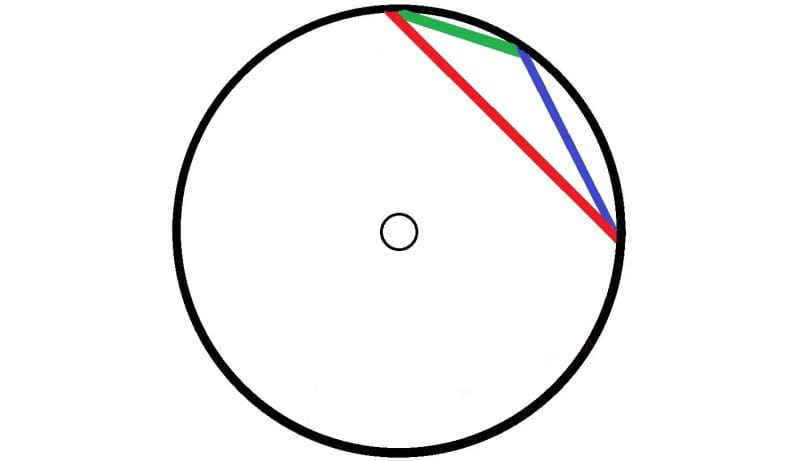A Small Learning Triangle is an aspect pattern with a red square, blue sextile, and green semisextile aspect. Three-colored aspect patterns are learning or development figures, in which the third color (green) plays an important role.
Green aspects bring a third point of view into the equation, which, for better or worse, supersedes the polarized thinking of the red and blue aspects with a third pole; green aspects allow an escape from black-or-white thinking and a search for causes, possible solutions and meaning.
The semisextile aspect represents a small thinking step which brings the information necessary to think objectively and neutrally. It helps you think in small steps, adding one piece of information to another until the collected perceptions make sense. It works by providing information, communicating, and reacting to external stimuli. It is easily influenced and often changes its opinion.
Crisis Mechanism
In the Small Learning Triangle, there is a procedure that conditions growth by an ongoing crisis mechanism that opens up great development opportunities. There are three phases to the crisis mechanism: red-green-blue.
The dynamic process starts with the red aspect (square). The point of conflict is where the red and blue aspects touch each other. The calm, balanced, pleasure-seeking state of the blue aspect (sextile) is disturbed or irritated, causing tension or conflict, and some decision or effort must be made. The old state is no longer tenable; a problem has arisen that must be solved.
red → green → blue
square → semisextile → sextile
conflict → striving for solution → harmonization
The red square aspect shows a regular and drastic experience of conflict due to feelings of inadequacy because of a particular problem.
The green semisextile aspect is the next step where the problem is initially dealt with. Searching for a solution can lead to a change in self-image.
The blue sextile aspect is the desired state of harmony from creative problem-solving. Ego transformation results in a more dominant and influential personality.
Learning and Development
The crisis mechanism in the Small Learning Triangle is a development spiral that aims to get another point of view with every complete transition. Every passage through the three phases and each crisis contains the possibility of finding solutions that previously did not exist, i.e., breaking new ground. Whether that is successful depends on your attitude toward the crisis process. If you inwardly recognize the opportunities, then development is likely. The development process will be blocked if you treat the crises as mere disruptions.
Communication and the provision of information usually lead to new experiences (green aspect). You are always ready to experiment, and the newly acquired discoveries lead you to try to establish a new, harmonious state in a still unsure and unstable position (green-blue contact point in the aspect figure), which meets the requirement of the initial problem. So, this process would seem to be complete. But only until a new problem comes along and the crisis mechanism gets going again:
conflict → striving for solution → harmonization
In the Small Learning Triangle, the aspect facing the center of the horoscope is the tension aspect, the square. The harmonious aspect, the sextile, is facing outward. The inner tension produces dissatisfaction with the external situation. The center stresses the inner need for growth, but dissatisfaction with reality can lead to conflict.
Repetitions
This process is repeated many times. Specific themes come to maturity and crop up again and again. Over the green semisextile, there is a search for new information in the environment with which to be able to resolve the tension of the square and to be able to live in harmony with the environment again.
You may be motivated by an inner unrest and dissatisfaction that those around you cannot explain. When questioned about it, your answers seem elusive. The blunt green-blue point of this triangle is where the dissatisfaction strikes. The Small Learning Triangle occupies only one-quarter of the horoscope, affecting only part of the character.
The main preoccupation is processing the experiences in the field of life concerned. You are not interested in an analysis of the contents of this area. You want to experience yourself via the permanent communication process in this area. The Small Learning Triangle is strongly oriented toward the environment.
Rotational Direction
The rotation direction is an important feature in evaluating the Small Learning Triangle. It is given by the color order:
red → green → blue.
Clockwise: in the opposite direction to the zodiac. This is a Retrograde Experience Triangle. It means that many experiences are required to achieve the necessary learning and development. It makes adapting to a more deep-seated problem harder and longer than if the direction were anticlockwise.
Anticlockwise: in the same direction as the zodiac. This is a Cognition Triangle. It means discoveries can be made rapidly because it provides the necessary insights when crises appear. The task to be learned is understood, and intelligence is used to find a solution. With time, you learn how to control and accelerate the process. An enthusiastic, positive attitude towards the theme makes it easier to resolve. The example at the top of this page is a Cognition Triangle.
